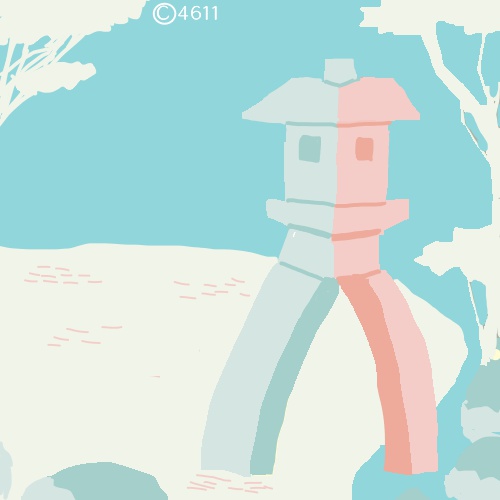本ブログは観光業、企業接待、留学生対応等で英語案内が必要ながら、多忙で準備に時間をかけられない方々の為にすぐに使える情報を分かりやすく解説しています。
今回は加賀百万石の歴史と文化を今に伝える『兼六園』をインバウンドに案内する際の英語表現についてご紹介します。本ブログは同じスポットでも多様な視点でカバーしており、全体ボリュームがありますので目次からピンポイントでご選択されることをお勧めします。👉直接インバウンドに向けてまとめた英語版ご参照の際はこちらからどうぞ!
👉タイトル各語について! 「石灯籠(いしとうろう」”stone lantern”、「雪吊り(ゆきつり)」”the work of stringing ropes for snow”、「腑に落ちる」”It makes sense.”という言い方が可能です。「腑に落ちる」はその他の類似表現含めて英語音声ファイルでリンク先『腑に落ちる』の英語表現で確認できます。
0. 本ブログの考え方(イントロ)
0.1 本ブログの基本構成
本ブログは大きくは下記の3構成になっています。各スポットは一般的な知名度順に並べてあります。
- 基本用語のご説明
- 兼六園全体のご説明
- 基本情報
- インバウンドの視点
- 笑いが取れるかも?説明例
- 各スポット毎のご説明
- 同上
0.2 本ブログの表現レベル&公式HPのご紹介
本ブログではインバウンドと混雑した雑踏の中を歩きながら、極力思考力を相手に求めない簡単な表現を心掛けておりますので、詳細情報や高度な描写をご要望の場合は下記の公式サイトで直接ご参照下さいませ。(いずれもトップメニューの言語でEnglish版に設定できます。)
兼六園|観光・体験|【公式】金沢の観光・旅行情報サイト|金沢旅物語 (kanazawa-kankoukyoukai.or.jp)
1. 押さえておきたい基本用語
色々な表現の前に、日常会話で使う基本用語から、他の庭園案内でも使える庭園マニア向け、並びに金沢兼六園特有表現までご紹介してますので、皆様のニーズに合わせご活用ください。
1.1 庭園基本用語(日常会話レベル)
日常会話で良く使われる代表例として。
- Three Great Gardens(日本3大庭園)
- auspicious occasion(慶事)
- waterfall(滝)
- fountain(噴水)
1.2 庭園関連用語(庭園愛好家レベル)
日常それほど使われませんが、庭愛好家で使われる代表例として。
- 回遊式庭園(複数)!stroll-style gardens
- 石灯籠!stone lantern/ a kind of traditional Japanese lighting fixture
- 縮景!‘reduced landscape’
- 見どころ!must-see feature
1.3 兼六園特有用語(高頻度使用)
他でも使われる用語もありますが、兼六園のイメージが強い代表例として。
- 雪吊り!the work of stringing ropes for snow/gardening methods using ropes for snow / ropes to protect branches from snow
- 👉全国各地の庭園毎に色々な英語表現がありますのであくまで一例として。日本語の「雪吊り」自体、正確な意味を表現できてませんので、直訳では当然通じず、日英共に補足が必要になります。
- 根上松(根が露出した松)!a pine tree with exposed roots,
- 繁栄と不滅を願って!with the hope of prosperity and eternal life.
- 👉前田家の兼六園に込めた願いです。
- 六勝「宏大、幽邃、人力、蒼古、水泉、眺望」!’spaciousness’, ‘seclusion’, ‘artifice’, ‘antiquity’, ‘water features’, and ‘panoramas’.
- 👉公式HPの兼六園の6条件の用語で、日本人でも口頭では中々伝わりにくいので、ネイティブには補足説明が必要です。
- 「日本三大庭園」の1つ!one of the ‘Three Great Gardens in Japan’
- 👉よく使われる表現ですが、もし他の2つを聞かれたら「後楽園」「偕楽園」言えるように。
2.兼六園全体
”About Kenrokuen Garden”
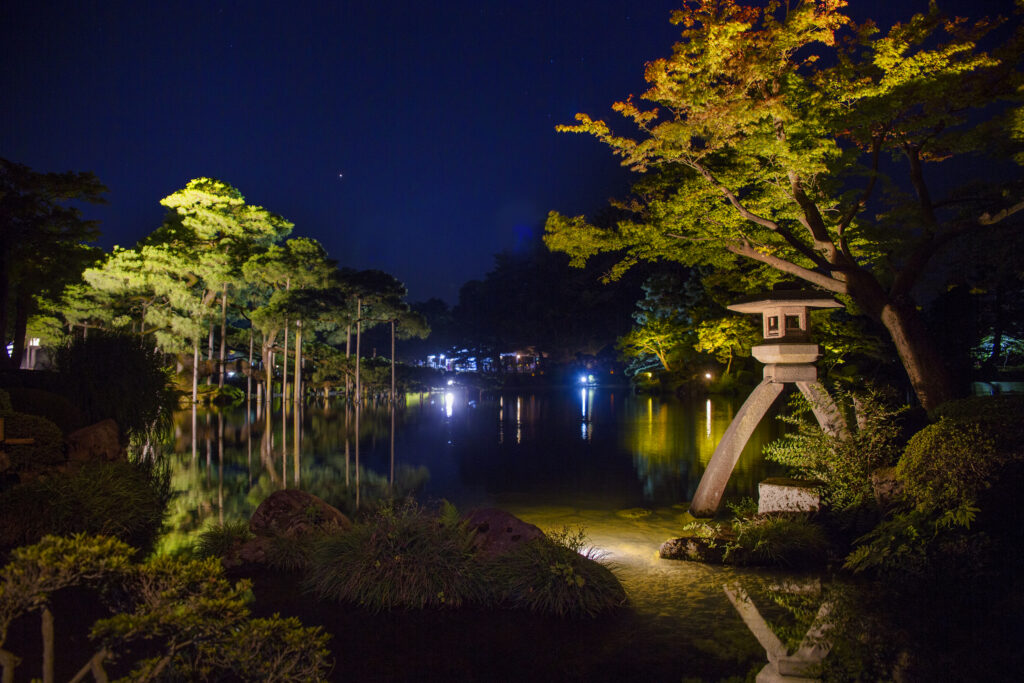
2.1 基本情報
インバウンド対応の前に押さえておきたいポイントです。これをこのまま説明するわけではありませんが日本語で理解している以上の英語説明はできませんので、その為の事前情報です。
- 兼六園は理想の庭園の為の6条件(美観)を持っている。
- 6条件は相互に相反しその両立が困難。
- 前田家のプライベート庭園として一族繁栄と長寿の願いが込められている。
- 各スポットの設計思想を知らないと兼六園はわからない。
- Kenroku-en garden has six requirements (,beauty) that make it an ideal garden.
- They are mutually conflicting and difficult to strike a good balance.
- As the private garden of the Maeda family, it was designed with the desire for family prosperity and longevity.
- Understanding the design philosophy of each spot is essential to enjoying this garden.
2.2 インバウンドの視点
👉多くのインバウンド(特に初訪日レベル)にとって、日本の庭園は金太郎飴的にただ広く、池や樹木があって花も綺麗だが、それぞれの背後にある意図(設計思想)も知らずに、ただそれだけで終わってしまう人が多く、見た時に素直に感じるであろうことを並べてみました。
- そもそものこの庭園は何のためにある?
- 名前は何という?
- どのような意味か?
- 何故ここに作られたか?
- いつ頃からあるのか?
- どんな人が作ったのか?
- どのように使っていたのか?
- 他の庭園との違いは何なのか?
- What is the purpose of this garden in the first place?
- What is its name?
- What does it signify or represent?
- Why was it built here?
- How long has it been here?
- Who designed and constructed it?
- How was it traditionally used?
- What distinguishes it from other gardens?
2.3 歩きながらの即答例
上記視点に対し、混雑した庭園の雑踏の中を歩きながら伝えるレベルのシンプルな回答例です。
- 金沢城主が一族繁栄を願って作らせた私庭です。
- ケン、ロク、エンと発音します。
- 👉Can rock yen, 『円を動かせる』の様に響くかも
- 六つの美をもった庭園の意味です。
- 金沢城と同じ高台の地続きの私有地だったから。
- 300年以上前、ニュートンが中年になった頃です。
- 当時全国有数の資産家領主、前田一族です。
- 池や滝、茶室が造られ一族や接待で楽しまれました。
- 他の庭園より美のボリュームが多いとよく評されます。
- This is a private garden created by the lord of Kanazawa Castle, wishing for the prosperity of their family.
- It is pronounced “Ken, Roku, En” . (Which may sound like “Can rock yen”) .
- It represents the garden having six beauties.
- It was located on the same hill as Kanazawa Castle and was privately owned.
- This was over 300 years ago, around the time when Newton was middle-aged.
- The Maeda family, one of the wealthiest landowners in the country at that time.
- Many facilities including ponds, waterfalls, and tea rooms were created to enjoy with their family and guests.
- It is often praised for having a larger volume of beauty than other gardens.
2.4 日本人視点の補足説明例
海外客の興味の対象でもある我々日本人の視点例です。
- 日本人は昔から庭園を回遊する(歩く)のが大好き。
- 四季の花を楽しみながら会話をする。
- なので、日本には回遊式庭園が多い。
- 兼六園はその代表的例として日本3大庭園の1つとなった。
- 日本人は日本の「3大」という表現が大好き。
- 同調圧力に弱い日本人は「唯一無二」という言い方はあまりしない。
- 兼六園含め日本庭園は古代中国の影響を受けている。
- しかし日本人の好みにより中国にない独自性がある。
- 大自然をそのままコンパクトに収めて楽しむ傾向がある。
- 兼六園は古代中国の理想庭園を凝縮して実現しようとした日本人気質の賜物。
- Japanese people have always loved strolling around gardens.
- While enjoying seasonal flowers, we engage in conversation.
- That’s why Japan has so many stroll-style gardens.
- Kenroku-en became one of Japan’s three great gardens as a typical example.
- Japanese people love the easy-to-understand expression of “Japan’s three great.”
- We, vulnerable to peer pressure, tend to avoid saying “one and only “.
- Japanese gardens, including Kenroku-en , have been influenced by ancient China.
- However, we create unique things not found in China due to Japanese preferences.
- We have tendency to enjoy compressing nature into a compact form like this.
- This garden is a fruit of great efforts trying to realize the ideal garden of ancient China compactly.
2.5 笑いが取れるかも?説明例
👉《笑いがとれるかも?》パートについて:実際の案内現場ではあり得ない、脱線の多い長い説明パートですが、日常会話でも使える色々な表現を意図的に織り込んで構成されています。それによりインバウンドのその時の状況に合わせて柔軟な説明ができることを目指しています。
日本文化に詳しい外国人想定例です。どこか使えそうなパートがもしあればお試しあれ。
a) この目の前の兼六園って何?
“What is this garden, Kenroku-en, in front of us?”
- This was the private garden of the lords of Kanazawa Castle, entertaining visitors as well.。
- ここは接待を兼ねた金沢城城主のプライベート庭園でした。
- The lords created this garden with the hope of their family’s prosperity and eternal life.
- 城主たちは一族の繁栄と永遠の命の願いを込めて作りました。
- 👉音声サンプルは下記 No1~2 ボタンで。
- You can discern their wishes from each spot.
- 個々の制作物でそれらの願いが読み取れます。
- But just by looking at them alone, you won’t understand anything like the Da Vinci Code.
- でも、ただ見ただけではダビンチコードと同じで何もわかりません。
- That’s why our guides are here to explain the code to you.
- そのコード説明の為に我々ガイドがご案内するわけです。
- But don’t worry, unlike the Da Vinci Code, no one has died, and there is no danger to you.
- でもご安心ください。ダビンチコードの様に誰も死んでいませんし、貴方に危険はありませんので。
- 👉音声サンプル は下記 No3~6 ボタンで。
b) なぜ『兼六園』と呼ばれる様になったの?
”What is the reason that this garden came to be called Kenrokuen?” / “Why is this garden called Kanazawa?”
👉同行前や同行中によく聞かれる質問ですので、それなりに備えておきたいですね。
👉👉Atention!! 👉👉本ブログ以外にも、『兼六園』の名前の意味、を質問された場合の対応例(相手レベルに合わせたシンプルパターン)を別ブログにて投稿致しましたので、もしご興味ございましたらリンク先でご参照くださいませ。
- The name Kenrokuen means “Ideal garden of having six beauties” .
- 『六つの美を備えた理想的な庭園』の意味です。
- 👉基本的にはこの回答でOKでしょうけど以下は状況に応じて。
- Since ancient times in China, six essential features have been required for a perfect garden.
- 古代中国以来、完全な庭園には6つの必須条件が求められていました。
- 👉why 6つ?と思う相手に対して使えます。
- It is said that an ideal garden is vast but delicate, artificial but natural, and beautiful both near and far .
- 理想的な庭園は広大だが繊細で、人工的だが自然的で、近遠とも美観を備えていると言われています。
- Actually it was almost impossible, but the castle lords tried to create a perfect garden.
- 実際にはほぼ無理ですが、城主たちは完全な庭園を造ろうとしたのです。
- Each condition contradicts the others, making it difficult to satisfy them.
- それぞれの条件は相反しているのでそれ故に両立が難しいのです。
- “On the official website, these six conditions are expressed in difficult terms: ‘spaciousness’, ‘seclusion’, ‘artifice’, ‘antiquity’, ‘water features’, and ‘panoramas’.
- 公式HPではその6条件を「宏大、幽邃、人力、蒼古、水泉、眺望」と難しく表現しています。
- These are not words that Japanese people use in their daily lives, so it may be difficult for them to understand just by hearing them.
- 普段使わない単語なので、日本人でも聞いただけですぐ理解することは難しいです。
- If we were able to make foreign visitors understand it, would it be fair to say that we could achieve an even more challenging task of fulfilling seven conditions?
- であれば、もし外国客にご理解いただければ、更に困難な7条件達成の偉業になりますかね?
c) 他の庭園とどこが違うの?
“What makes Kenrokuen Garden different from other Japanese gardens?”
👉残念ながら数値的な客観データでNo1と言えるものは特にないので、一例として。前半部(No1~5)と後半部(No6~10)は少しトーンが違いますのでご注意くださいませ。
- Kenrokuen Garden is one of the ‘Three Great Gardens in Japan’.
- 日本三大庭園の1つです。
- Many people highly evaluate this gardens as having a high degree of completion as a Japanese garden.
- 多くの人が日本庭園として完成度が高いと評価しています。
- Completion here refers to beautiful scenery like a painting created by humans.
- ここでいう完成度とは、人が作り出した絵画のような美しさです。
- The garden designers tried to draw various beautiful pictures based on the lords’ intention.
- 庭園の設計者は領主の意図を踏まえ色々な美しい絵を描こうとしました。
- Here, you can see various garden techniques that created that beauty.
- ここでは、その美を作り出す様々な庭園技術が見られます。
- Other gardens are equally beautiful, but there is one big difference.
- 他の庭園も同様に美しいですが、一つ大きな違いがあります。
- Other gardens have names with good sound and easy-to-use words.
- 他の庭園は名前も音の響きも良く、使いやすい単語なのです。
- So, the same names are often used for baseball fields, Chinese restaurants, yakiniku restaurants, ramen shops, and so on.
- なので、野球場や中華料理や焼き肉店、ラーメン屋等で同じ名前がよく使われます。
- However, the name of Kenrokuen is not often used.
- ですが、兼六園の名前だけはあまり使われません。
- Probably, no one has the confidence to offer complete entertainment or cuisine that meets all six criteria.
- 6つの条件を満たす完全な娯楽や料理を出すほどの自信はどこもないのでしょう。
3.徽軫灯籠(ことじとうろう)
“Kotoji-toro / Kotoji Stone Lantern”

3.1 基本情報
- 兼六園のシンボルとして国内では有名な写真撮影定番スポット
- 元々は池の水面を照らすための雪見灯篭であった
- 形が日本の弦楽器(琴)の弦を支える台(琴柱:ことじ)を連想させる
- 新年等の慶事で使われる琴の演奏会の図と見る人が多い
- 手前の橋が琴本体で灯篭は弦を支える台の構成
- 灯篭の二股の両足の長さが異なっている理由は諸説あり
👉外国客にはそのままでは使えない表現ばかりですが、持ってて安心情報として。
- As a symbol of Kenrokuen Garden, it is a well-known photography spot in Japan.
- Originally, it was a stone lantern, called yukimi toro, used to illuminate the surface of a pond.
- Its shape resembles a “koto-ji,” which is a stand for supporting the strings of a Japanese stringed instrument called a “koto.”
- Many people see it as a depiction of a koto performance during celebratory events such as the New Year.
- The lantern is positioned by a bridge, which represents the body of the koto, and the lantern’s legs symbolize the stands that support the koto’s strings.
- There are various theories as to why the legs of the lantern have different lengths.
3.2 インバウンドの視点
👉金沢城の石川門と同様、この灯籠は兼六園の象徴ですが、多くの初見の訪日外国人にはいったい何が特別なのかよくわからないでしょう。デンマークの人魚姫を実際に観て、その小ささにがっかりした、と言った話はよく聞きますが、同様の印象を持つ人はいるかもしれません。日本人の定番、琴見立てはここに入れていません。
このパートでは、口に出さなくても、眼の前の琴柱スポットを見てインバウンドが素朴に感じるであろう5w1h系の想定質問8文と回答例8文をカバーしています。いずれも単純な質問文ですが、いつも通り日本語、英語の順番です。
《日本語質問》
- なぜここはこんなに見物人が多いのですか?
- なぜここは写真スポットなのですか?
- ここの何が良いというのですか?
- この石の塔はなんなのですか?
- これは何のために建てられたのですか?
- この石の塔は何というのですか?
- これはいつ頃に建てられたのですか?
- 他の石の塔と何が違うのですか?
《英語質問》
- Why are there so many sightseers here?
- Why is this place a popular spot for taking photos?
- What makes this place so special?
- What is this stone tower?
- Why was it built?
- What is the name of this stone tower?
- When was it built?
- How is it different from other stone towers?
3.3 歩きながらの即答例
前パートの想定質問に対する回答例です。タイトル通り、雑踏の中を歩いてやりとりできるように簡略化に努めましたが、それでも長く感じるところ多々ありますね。
- 長年このスポットが兼六園の商標の様に使われ続け、その象徴となったからです。
- デンマークの人魚姫と同様、多くの訪問者にとって金沢に来た証拠になるからです。
- 多くの日本人はこのスポットの様に美しい背景にシンプルな構造物の絵画的構図が好きなのです。
- これは雪見灯篭という日本の伝統的な照明機器で、ろうそくを使うのです。
- 元々は灯りをつけた時に隣にある池の表面をより美しく見せる為に作られました。
- これは琴柱灯篭といって、琴という弦楽器の弦を支える台に例えて名付けられました。
- 約200年前に庭園が何度か拡張される中でここに設置されました。
- 通常雪見灯篭は1本足なのに、これは2本脚なのでおしゃれに見えます。
《英語回答例》
- This spot has been used as a trademark of Kenrokuen for many years, making it a symbol of the garden.
- Similar to the Little Mermaid in Denmark, it serves as evidence for many visitors that they have come to Kanazawa.
- Many Japanese appreciate picturesque compositions with simple objects set against such a beautiful background, just like this spot.
- It’s a traditional Japanese lighting device known as a Yukimi lantern, which uses a candle.
- It was originally constructed to enhance the beauty of the neighboring pond’s surface when illuminated.
- This is known as a kotoji-toro, named after the stand that supports the strings of a stringed instrument called a koto.
- It was installed here approximately 200 years ago during one of the garden’s expansions.
- While Yukimi lanterns typically have a single leg, this one looks fashionable with its two legs.
3.4 日本人の視点
定番の「琴と琴柱」の例えは日本人の視点で触れています。
- 日本人は絵葉書によく描かれるような単純な構成の絵が好き。
- 例えば富士山だけの絵が、昔から色々なスタイルで無数にある。
- この琴柱灯篭の風景は富士山に並ぶほど日本人好みの構図。
- 長年、多くの日本人がここを訪れ、色々な脚色を加えた。
- その一つが手前の橋の琴と石灯篭の琴柱の物語。
- 日本人は唯の石をペットにする人がいる位の想像好き。
- この灯篭の様にどんなものにも「幸運」や「慶事」に繋げたがる。
- この石灯篭と橋の例え話はその日本人気質を的確に伝えている。
- Japanese people like pictures of simple compositions, like often depicted in postcards.
- The image of Mount Fuji alone has countless variations in style since ancient times.
- The scenery of this stone lantern is a typical style that Japanese people love just as much as Mount Fuji.
- Over the years, many Japanese people have visited here and added various stories.
- The story of the stone lantern and bridge in front resembling a koto and its pillar is one of classic cases.
- Japanese people have rich imaginations, such as imagining a simple stone as a pet.
- We like to associate “luck” or “auspicious things” with anything like this lantern.
- This analogy of the lantern and bridge accurately conveys the Japanese temperament.
3.5 笑いが取れるかも?説明例
👉《笑いがとれるかも?》パートについて:実際の案内現場ではあり得ない、脱線の多い長い説明パートですが、日常会話でも使える色々な表現を意図的に織り込んで構成されています。それによりインバウンドのその時の状況に合わせて柔軟な説明ができることを目指しています。
ここは、敢えてネガティブな人の想定例。
a) この灯籠がどうしたの? / 何が珍しいの?
“What is this lantern?” / “What is special about it?”
👉公式サイトの説明が望ましいですが、日本人でも聞いただけではよくわからないので、あくまで一例として。ここにはこんな意図があるんです、って程度に留めてみました。手元のスマホで琴の画像を見せると分かり良いかもですね。ここも音声サンプルは前半No1~5と後半No6~10のトーンが異なりますのでご注意ください。
- This is not just an ordinary ornament, stone lantern.
- これは唯の置物の石灯篭ではありません。
- Here, an auspicious scene is being expressed wishing happiness.
- ここでは, ある御目出度い場面が表現されています。
- It is a scene of a concert using Koto, Japanese traditional instrument.
- それは琴の演奏会です。
- It is often played at auspicious occasions such as New Year’s Day and weddings.
- 琴はお正月や結婚式のようなおめでたい席で演奏されます。
- The bridge in front resembles a koto, and the stone lantern is a stand that supports the strings of the koto.
- 手前の橋が琴で、石灯篭は琴の弦を支えるスタンドなのです。
- It is said that despite a typical stone lantern having three or four legs, this lantern has only two legs in order to look like a stand for strings.
- 通常、石灯篭は3本から4本足なのに、この灯篭の足が2本なのは琴柱に見せるためだと言われています。
- While having only two legs makes it unstable, this instability may actually evoke empathy from people.
- 2本足だと不安定ですが、その不安定さがかえって人の共感を呼ぶのかもしれません。
- Yes, humans eventually become three-legged with a cane as they age.
- そうですね、人間だといずれ杖をついて3本足になりますので。
- So, this lantern seems like a person before reaching old age.
- この灯篭は高齢になる前の人間のようですね。
- However, this lantern has been standing here for over two centuries, so it is already quite elderly.
- でも、この灯篭は2世紀以上ずっとここに立っているので、十分高齢です。
b) どうして皆さんこんな風に並んでいるんですか?
“Why is everyone lined up like this?”
👉非常によく聞かれる質問なので、いつも通り、前半(No1~6)は説明案内にも使える真面目パート、後半(No7~14)の雑談力UP用のおふざけパートの2部構成で纏めてみました。ここも音声サンプルは前半と後半の2ファイルです。
- This is a famous spot where many people take pictures as a memory and proof of their visit to Kanazawa.
- これは金沢を訪れた思い出と証として、多くの人が写真を撮る有名スポットなんです。
- It is similar to the Little Mermaid statue in Denmark, the Merlion in Singapore, or Big Ben in England.
- デンマークの人魚姫像やシンガポールのマーライオン、イギリスのビッグベンに似ていますね。
- Japanese people have always appreciated the simplicity of landscapes, and the stone lanterns and pond in the background perfectly match their aesthetic preferences.
- 日本人はいつもシンプルな風景を好むので、石灯籠と背景の池は日本人の好みにぴったりはまるんです。
- Over the years, through its frequent appearances in photographs, on TV, and in magazines, this view has become an iconic symbol of Kanazawa.
- 長年にわたり、写真やテレビ、雑誌で頻繁に取り扱われることで、この景色は金沢を象徴するものとなりました。
- Many visitors now wait in line to walk on the stone bridge and have their photo taken from this spot.
- 今では多くの観光客が、石橋の上を歩いてこの場所から写真を撮るために列を作って待っているんです。
- If you think it’s worth it, why not join the line? It will be a memory that lasts a lifetime.
- 待つ価値があるとお思いでしたら、列に加わられたら如何でしょう? 一生の思い出になりますよ。
- Many tourists line up for this experience, while some choose to move on to the next spot.
- 多くの観光客は列に並んでこれを体験しますが、次のスポットに行く人もいます。
- For instance, those who aren’t interested in trends, prefer to avoid crowds, or don’t like having their picture taken usually pass by without waiting.
- 例えば、流行に興味がない人、人混みを避けたい人、写真を撮られるのが嫌いな人は、たいてい待たずに通過します。
- There are many different types of people, and after years of guiding visitors to this popular spot, I’ve noticed that their personalities often come through here.
- いろいろなタイプの人がいまして、この人気スポットを何年もご案内していますと、それぞれ個性がよく出ていることに気がつきます。
- Recently, I even discovered a new type of personality—because I found myself fitting into that category.
- 最近、私は新しいタイプを見つけたんです。というのも、自分が当てはまることに気づいたので。
- I sometimes wonder if the stone bridge has accumulated structural fatigue from the countless people who have crossed or lingered on it over the years.
- 私は時々、この石橋は長年、数え切れないほどの人々が渡り、立ってきたため、構造的疲労がたまっているのではと思うことがあります。
- There is a type of person who constantly worries that the bridge might collapse one day, just by chance.
- ある日突然、橋が崩れてしまうのではないかと心配するタイプの人がいるんです。
- This cautious type will never cross it, no matter how much I recommend it.
- この用心深いタイプは、私がいくら勧めても決して渡らないんですね。
- It’s like the saying: ‘knocking on a stone bridge before crossing it—and then never crossing it at all!’
- この諺通り。「石橋を叩いて渡る、でも、決して渡らない」
4.眺望台(ちょうぼうだい)
“Panoramic View Point / Panoramic Lookout”
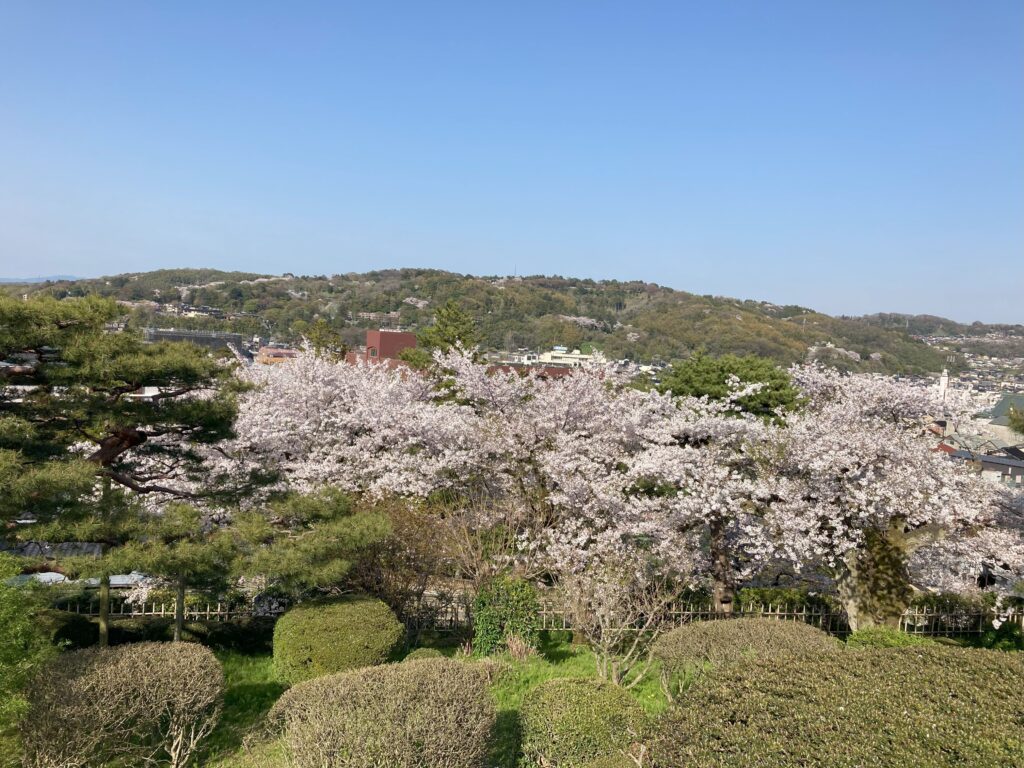
4.1 基本情報
このスポットで押えておきたいポイントですが、そのまま説明にも使える様に更新しました。
- このスポットでは兼六園の六つの美観の中の「眺望」を見せてくれます。
- ここは庭園内で唯一、外の風景が楽しめる貴重な場所です。
- 兼六園は本来領主専用のものなので一般庶民からその美しさは見えないように作られています。
- ここからの風景を楽しめるのは領主やその招かれた人達だけでした。
- 天気と視界が良い日には左側に日本海と砂丘が見えます。
- 春の桜のシーズンには眼下に満開の桜の木々が見下ろせます。
- 正面の山はここから北東方向にあるのに、南東の山の意味があり、少し謎めいています。
- 丘の様な低山ですが、昔は一般登山は禁じられていましたました。
- 主な理由は軍事的、保安上のもので、その頂上から市内が一望に見下ろせるためでした。
👉これまで通り、このままでは使えない表現ですが、会話の材料として。
- This spot offers the ‘panoramic view,’ one of the six beauties of Kenroku-en Garden.
- This is the only precious spot in the garden where visitors can admire the outside scenery.
- Kenroku-en Garden, originally designed exclusively for lords, was crafted to conceal its beauty from the general public.
- Only the lords and their guests were allowed to enjoy the scenery from here.
- On a fine day with good visibility, the Sea of Japan and the dunes can be seen on the left.
- During the cherry blossom season in spring, you can look down on the cherry trees in full bloom below.
- The mountain in front is in the northeast direction from here, yet the name is meant to be a southeast mountain, which is a bit of a mystery!
- It is a low hill-like mountain, but in the past, public climbing was forbidden.
- The main reason was for military and security purposes, as the summit overlooked the entire city.
4.1 インバウンドの視点
日本人であれば言葉少なくただ眺めながら、山の名前とか会話していれば良いですが、殆どの訪日外国人にはイマイチ高さに欠け風景だけで訴えるのは厳しいので、人間臭い話とか、何かで印象カバーしたいところですね。
4.2 笑いが取れるかも?説明例
👉《笑いがとれるかも?》パートについて:実際の案内現場ではあり得ない、脱線の多い長い説明パートですが、日常会話でも使える色々な表現を意図的に織り込んで構成されています。それによりインバウンドのその時の状況に合わせて柔軟な説明ができることを目指しています。
👉入場して直ぐ、六勝の一つ「眺望」を紹介するには最適な場所ですが、生憎、天候と視界が悪く遠方
(日本海や砂丘)が見えないケースを想定してみました。ここも音声サンプルはトーンが異なる前半(No1~5)と後半(No6~8)で話者を変えて置きました。もし使えそうなセリフがあればお試しください。
- One of the six beauties, “Panoramic View,” can be experienced here.
- 六勝の一つ「眺望」がここで体感できます。
- If the weather and visibility had been fine, we could have seen the Sea of Japan on the left.
- もし天候が良くて、視界が良好であれば、左側に日本海も見えたのですが。
- The mountain in front of us used to be off-limits to commoners for climbing because it overlooked the city.
- 正面に見える山は、昔は市内が見下ろせるため庶民の登山は禁止でした。
- Only government officials for city surveillance were allowed to climb to the summit.
- 頂上に登れるのは市内監視の為の役人だけでした。
- As Kenroku-en is located on the hill, an observation deck was limited to this spot where you can see the city below.
- 高台にある兼六園からも市内が見下ろせるのはこの眺望台だけです。
- In other words, only special invited guests were allowed to stand here in the past.
- つまり昔はここに立てるのは特別な招待客だけだったです。
- But now, the number of these special invited guests amounts to several million annually.
- でも今はその特別な招待客は年間数百万になります。
- It may be pitiable for Kanazawa citizens to be monitored by such a large number of people every day.
- こんな大勢の人に連日監視される金沢市民は可哀そうかもしれません。
5.霞ヶ池(かすみがいけ)
“Kasumiga-ike Pond”
5.1 基本情報
ここは説明の為の背景知識をまとめたものですが、そのまま説明にも使える様に内容更新しました。
《日本語》
- 一般的に日本庭園には必ず大きな池があり、この池は兼六園のほぼ中央に位置し、庭園の心臓部のようです。
- この池の周りには様々な仕掛けが施されていて、散策しながら楽しむことができます。
- 多くの日本庭園ではしばしば「縮景」と呼ばれる造園技法が採られていて、日本の名勝を小さくしたものが庭のデザインとして取り入れられています。
- 例えば、この池はその手法を使って日本最大の湖(琵琶湖)を模しています。
- その湖は隣接する京都とセットで古来より政治と文化の中心で憧れの対象でした。
- 池の中に見える小島はその大きな湖の中にある不老父不死の伝説を持つ有名な島を模しています。
- その小島の形は長寿の象徴であるカメの甲を表していて、その端には亀の頭に似せた石が置かれています。
- この池は霞ヶ池と名付けられ、広大さを意味していて、対岸が霞んで見えない位のイメージを表現したい気持ちが現れています。
- この池は特別な軍事的な仕掛けがあり、有事の際、庭園オーナーの住む金沢城の防御力を高めています。
- この池の水は池の底から抜けるように設計されていて、庭園と金沢城の間にあった堀に流れ込み、堀の水位が上がるようになっています。
《英語》
- In general, Japanese gardens always have a large pond, and this pond is almost located in the center of Kenroku-en garden like the heart of the garden.
- There are various devices placed around the pond for visitors to enjoy while walking around.
- In many Japanese gardens, a gardening technique known as the ‘reduced landscape’ is often employed, where small-scale replicas of famous scenic spots of Japan are incorporated into the garden design.
- For example, this pond has been modeled after Japan’s largest lake, Lake Biwa.
- The lake, together with the adjacent Kyoto, has been the center of politics and culture and an object of admiration since ancient times.
- The small island visible in the pond is a replica of an island in the same lake that is famous for its legend of immortality.
- The shape of the islet represents the shell of a turtle, a symbol of longevity, with a stone resembling a turtle’s head placed at its edge.
- The pond was named ‘Hazy Pond,’ reflecting the idea of its vastness, with the desire to evoke the image of the opposite shore being obscured by haze and thus invisible.
- This pond had a special military function that enhances the defenses of Kanazawa Castle, a residence of the garden’s owner, in the event of an emergency.
- The water in this pond was designed to drain from the bottom of the pond and flow into the moat between the garden and Kanazawa Castle, raising the water level of the moat.
5.2 インバウンドの視点
👉日本人にとっては琴柱灯篭に続くお馴染みの嬉しい風景ですが、初めてこれを見るネイティブにはよくある日本庭園の池なので、何も言わないと、きれいですね、広いですね、だけで印象にも残らないかもしれません。
5.2 笑いが取れるかも?説明例
👉《笑いがとれるかも?》パートについて:実際の案内現場ではあり得ない、脱線の多い長い説明パートですが、日常会話でも使える色々な表現を意図的に織り込んで構成されています。それによりインバウンドのその時の状況に合わせて柔軟な説明ができることを目指しています。
a) この池はどれくらい広いのですか?
“How big is the pond in Kenroku-en?”
ここでは池の広さが話題になった際のネタで纏めてみました。👉英語音声は前半(1-4)の真面目パートと後半(5-7)のおふざけパートは話者が異なります。
- This pond extends to that house,a tea room, visible in the distance.
- 向こうに見える茶室まで広がっています。
- 👉対岸の茶室(内橋亭/うちはしてい)が見える位置にいれば。
- But, The name of the pond, “Kasumi,” meaning haze, also implies that it is so vast that you cannot see the opposite bank.
- でも池の名前は霞で対岸が見えないくらい広いという意味も込められています。
- Would “hazy pond” be an appropriate translation in English?
- 英語に訳すと”hazy pond”(霞のかかった池)でしょうか?
- Therefore, ultimately, the size of the pond is “hazy.” so unclear.
- なので、結局のところ池の広さは”hazy”、つまりはっきりわからないですね。
- Actually, the size of this pond is a little smaller than a soccer field, but whether it feels bigger or smaller varies from person to person.
- 実際のところ、この池の大きさはサッカー場より一回り少し狭い位なのですが、広く感じるか狭く感じるかは人によって様々です。
- Especially when compared to its soccer field, for soccer enthusiasts, the pond seems to be less and less spacious.
- 特にそのサッカー場と比べる話しを聞くと、サッカー好きの人にはこの池は益々広く感じないようです。
- In soccer, when the opponent is so strong that you cannot get close to the opponent’s goal at all, people often use the expression that the opponent’s goal is too far away and ‘hazy’ to be seen clearly.
- サッカーでは相手が強すぎて、相手ゴールに全く近づけない時、皆さんよく言います。相手ゴールが遠く霞んでよく見えないと。
b) 池の辺りの多くの見どころって何ですか?
“What are the main must-see features around the pond?”
ここでは池の中の蓬莱島の亀の例え話をする際のネタで置いてみました。👉観光客向けの定番ネタですが、大半のネイティブに島の名前まで説明するのは難しいのでここでは触れていません。
- Many things are created with wishes for longevity and prosperity.
- 多くのものが長寿と繁栄の願いを込めて作られています。
- For example, the island in the pond is made to resemble a turtle.
- 例えば、池の中の島はカメに似せて作られてます。
- The turtle is a symbol of longevity in Japan, having been believed to live for ten thousand years.
- 日本ではカメは万年生きると信じられてきた長寿の象徴です。
- Does that island look like a turtle? Does it look like fun?
- あの島はカメに見えますか?楽しそうに見えますか?
- I personally couldn’t bear to just sit still like that for 10,000 years.
- 1万年間もじっとそうしているなんて、私にはとても耐えられません。
c) この池の何が面白いのですか?
“What makes this pond interesting? / What makes it special?”
池の水深の話になった際の想定ネタです。👉勿論こんなことは言わないでしょうけど、そう感じてそうな顔している人向けの一例として。
- This is the largest pond here and has a very deep water depth.
- この池は庭園内最大の池で水深もとても深いのです。
- One reason was that it was necessary to store a large amount of water for defense.
- 一つの理由として防御の為に大量の水を溜める必要があったのです。
- For an emergency, there is a mechanism to drain the water from the bottom of the pond, and raise the water level of the outer moat.
- 非常時には池の水が底から抜けて外の堀の水位を上げる仕掛けがあります。
- Since Kenroku-en also served as a defense for Kanazawa Castle, there are other such mechanisms in the garden.
- 兼六園は金沢城の防御も兼ねていたので他にもそのような仕掛けが見られます。
- But, we refrain from explaining all of our defense mechanisms, given the recent international situation.
- でも、最近の国際情勢を鑑みて、防御の仕掛けを全てご説明することは控えております。
- That’s because we cannot predict when a visitor’s home country may become an enemy nation and attack Japan.
- なぜなら、訪問客の母国がいつ敵国となって、日本に攻めてくるかわかりませんので。
6.唐崎松(からさきのまつ)
“Karasaki Pine Tree”
6.1 基本情報
ここも一般的なインバウンドの関心の薄い「唐崎松」や「琵琶湖」等の具体名はありません。
《日本語》
- この松は元々地元の松でなく遠方(関西)から取り寄せられた著名なブランド黒松です。
- 当時の領主は庭に面白さを加え招待客を喜ばせる為にその種を入手して育て上げました。
- ラストサムライ時代からほぼ200才に近い老松ですが、庭園の松の中でもスター的存在です。
- 毎年、雪の重さから枝を守る為の縄をはる作業(雪吊り)はこの松からスタートします。
- 作業開始日の11月1日にはTV放映の為のカメラマンとスマホを構えた多くの見物人でこの周辺はとても賑わいます。
《英語》
- This pine tree is not native to the area, but rather a renowned variety known as the black pine, imported from afar (Kansai).
- The lords of the time acquired its seeds and cultivated it to enhance the beauty of this garden and delight their invited guests.
- The old pine tree is nearly 200 years old since the days of the Last Samurai, but it stands out as the star among the many pine trees in the garden.
- Every year, the work of stringing ropes (Yuki-tsuri) to protect the branches from the weight of snow starts from this pine tree.
- On November 1, the day the work begins, this area around this tree will be crowded with professionals for the TV broadcast and onlookers with their smartphones.
6.2 インバウンドの視点
👉庭園マニアには定番の雪吊りの松ですが、冬でなければ殆どのインバウンドには沢山ある松の1つでしょう。琵琶湖の唐崎松の背景を口頭で伝えるのは困難なので、由緒ある特別なものであることだけは伝えたいですね。
6.3 笑いが取れるかも?説明例
👉《笑いがとれるかも?》パートについて:実際の案内現場ではあり得ない、脱線の多い長い説明パートですが、日常会話でも使える色々な表現を意図的に織り込んで構成されています。それによりインバウンドのその時の状況に合わせて柔軟な説明ができることを目指しています。
a) 他の木も吊るされてますが、この木は何か特別なのですか?
👉ここも前半(No1~6)と後半(No7~9)はトーンが(話者も)変わります。
“Is there something special about this tree? Other trees’ branches are also hung like this.”
- Certainly, this measure for snow can be seen in other Japanese gardens.
- 確かにこの雪対策は他の日本庭園でも見られます。
- This is special black pine that the lord brought all the way from a distant pine forest famous for its scenic beauty.
- これは特別な黒松で領主がわざわざ名勝で有名な遠方の松林から持ち込んだものです。
- The meandering branches, stretched out like petals of a large flower, are balanced and beautiful like a model, and are loved by many people.
- 蛇行した枝を大輪の花の様に張り巡らせる様は均衡が取れていてモデルのような美しさがあり多くの人に愛されています。
- Every year, the rope is put on this tree first, so many people come to take pictures.
- 毎年ロープがかけられのはこの木が最初で、多くの人が撮影にやってきます。
- Starting with this pine tree, around 800 trees in the garden will take this measure.
- この松を皮切りに庭園内の約800本の木にこの作業がされます。
- This work is performed by a total of about 500 workers over a period of about a month and a half, and the highly skilled gardening technique can be seen.
- この作業がされるのは延べ約500人の人数で約1カ月半の間のことで、その高度な庭師の技が見られます。
- Do you know? Many of gardeners doing this rope work are local Kanazawa municipal workers.
- ご存知ですか?このロープ作業をする庭師たちの多くは地元金沢の地方公務員なんですよ。
- I envy them. They are able to take care of pine trees instead of people.
- 羨ましいですね。人の代わりに松の世話ができるなんて。
- That’s because that pine trees don’t complain.
- だって松は苦情をいいませんもの。
b) 松は生命力ある強い木なのに何故そんなに世話をするのですか?
”Why do people take so much care of pine trees when they are so vital and strong?”
👉8文と長めですが、各文章は短いので英語音声ファイルは1本で置きました。話者は松木の葉先どの鋭さはない米国女性話者です。👉👉このパートの演習ツールはこちらよりお試しください。!
- As you say, pine trees are vigorous trees that can grow on sandy beaches and rocks.
- おっしゃる通り、松は砂浜や岩の上でも生育する生命力の強い木です。
- For this reason, it has been cherished since ancient times as a symbol of “patience,” a virtue of the Japanese people.
- その為、日本人の美徳の「忍耐」の象徴として古来より大切にされてきました。
- However, the pine’s unique tree shape and beautiful, artfully arranged evergreen leaf tips are the result of human collaboration.
- ただ、松の個性的な樹形と芸術的に整えられた美しい常緑の葉先は、人間とのコラボによるものです
- Many people also mistakenly believe that the pine groves that stand on the sandy beaches of the coast are naturally this way.
- また、多くの人が海岸の砂浜に立つ松原は自然にこうなったと勘違いしています。
- The beautiful pine forest landscape of the coast as well as the gardens is the result of many centuries of labor by the Japanese.
- 庭園だけでなく海岸の美しい松林の景観は日本人の数世紀に渡る労力によるものです。
- If the pine tree is a symbol of patience, then the Japanese who spare no effort in taking care of it may be said to be patience itself.
- 松が忍耐の象徴なら、その世話に労力を惜しまない日本人は忍耐そのものと言えるかもしれませんね。
- Therefore, the pine trees in Kenrokuen, the fruit of many years of gardener’s skill and patience, are not just pine trees, but perhaps should be called fine trees.
- それ故、長年の庭師の技と忍耐の成果である兼六園の松の木は単なるパインツリー(松の木)でなくファインツリー(素晴らしい木)と言うべきかもしれません。
- But for those who feel they are forced to take care of pine trees as their job, it may be a pain tree that requires a great deal of patience!
- でも、松の木の世話を仕事としてやらされている感の人には、多大な忍耐を強いられるペインツリー(苦痛の木)かも!
7.根上松(ねあがりのまつ)
“Neagari-no-Matsu / Raised Roots Pine”
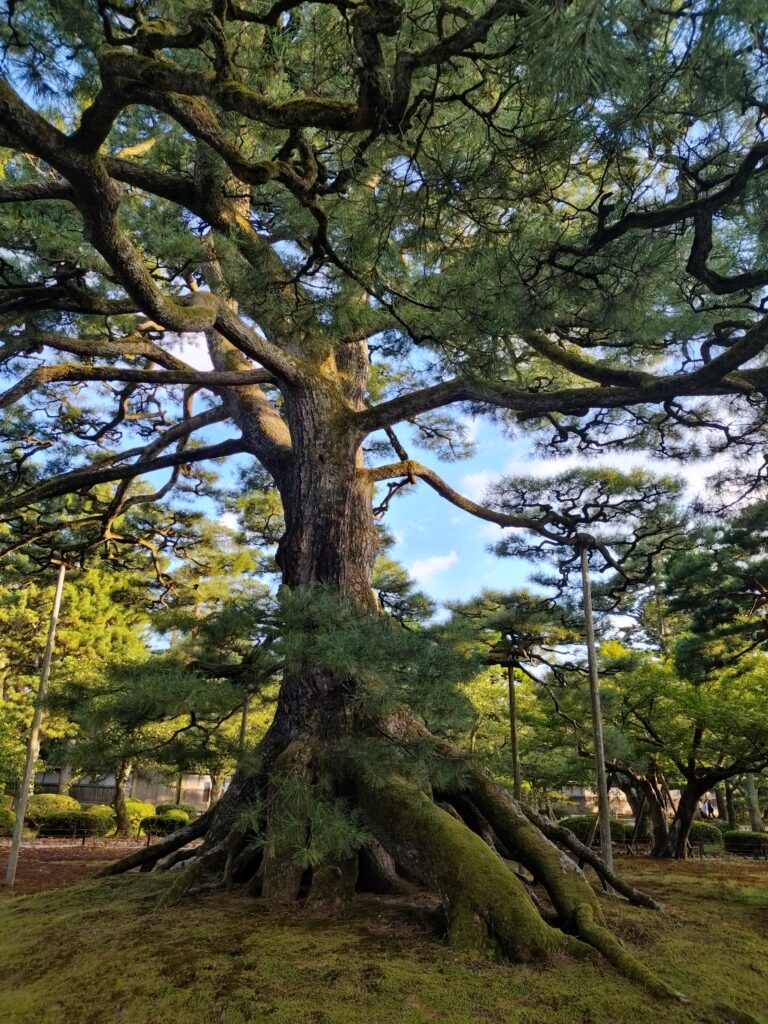
7.1 基本情報
- 高さ約15メートルの松の根が露出したクロマツ。
- 自然に育ったものと勘違いする人もいる。
- 根が見えた状態に育てるのは盆栽でよく見られる手法。
- 露出していても約40本の根があるため枯れない。
- その逞しさにあやかろうと根に触れた人が多かった。
- 現在は触れないように柵で保護されている。
- 老木に見えるが千年近く生きる松としてはまだ2百歳の若木。
👉ポイントが多くなりましたが、ここも見ただけではわからないことが多いので。
- A black pine tree with exposed roots, approximately 15 meters tall.
- Some people mistake it for naturally grown roots.
- Growing a tree with its roots visible is a technique commonly seen in bonsai.
- Despite its roots being exposed, it does not wither since it has around 40 roots.
- Many people have touched its roots in admiration of its robustness.
- However, it is now protected by a fence to prevent any further damage.
- Although it may appear as an old tree, it is still a relatively young tree at around 200 years old, considering that a pine tree can live for nearly a millennium.
7.2 インバウンドの視点
👉あらかじめ知っている日本人観光客と違って、周りは松ばかりで、初見のインバウンドの多くは何も気が付かず素通りしてしまうので、上記ポイントからこれはと思うワードで止まらせられたら良いですね。
7.3 笑いが取れるかも?説明例
👉《笑いがとれるかも?》パートについて:実際の案内現場ではあり得ない、脱線の多い長い説明パートですが、日常会話でも使える色々な表現を意図的に織り込んで構成されています。それによりインバウンドのその時の状況に合わせて柔軟な説明ができることを目指しています。
a) この松がどうかしたのですか?
”Is there anything special about this pine tree?”
👉今回は自然にこうなったのでなく、趣向を凝らす盆栽の手法であることを伝えるパターンです。ここも、前半(No1~5)と後半(No6~10)でトーンと話者が変わります。
- This pine tree is very unusual in Japan showing more than 40 roots raised about 2m on the ground.
- 40数本もの根が地上2mにまでせり上がった国内でもたいへん珍しい松です。
- This pine tree has been intentionally grown with exposed roots.
- この松は意図的に根を露出させたものです。
- This type of tree is often seen in bonsai.
- このような根上松は盆栽でよく見られるものです。
- Bonsai is a Japanese art form of growing and training miniature trees in containers.
- 盆栽とは日本式のミニチュア樹の育成法です。
- 👉今や海外でも大人気ですが、もし盆栽について聞かれた場合に使えます。
- There is also another technique of wrapping wire around trees to grow them into unique shapes besides this way.
- この手法の他にも、木に針金を巻いて珍しい形に育てる手法もあります。
- But it seems cruel to twist the natural growth of trees for human convenience.
- でも、人間の都合で自然の成長を捻じ曲げられるなんて木が可哀そうな気もします。
- This uprooted pine tree seems to have been forced to stand on its tiptoes for years suffering greatly.
- この根上がりの松も無理やりつま先立ちをさせられて大変かもしれません。
- In another perspective, this pine tree might be happy to stand out and look beautiful.
- 逆に、美しく際立ってみられてこの松も喜んでいるかもしれませんが。
- Humans are also willing to stand on their tiptoes in high heels for long time to look more beautiful!
- 人間だって美しく見せるため自らハイヒールでずっとつま先立ちしているではありませんか。
- So, that means high heels might be more pitiable than this pine tree.
- ということは、この松よりハイヒールの方が可哀そうかもしれませんね。
8.噴水(ふんすい)
“Fountain”
8.1 基本情報
- 日本最古の噴水と言われている。
- 金沢城に水を引く前の試作として造られたと伝えられている。
- 噴水より高い位置にある霞ヶ池を水源としている。
- 池との高低差を利用した水圧で吹き上がっている。
- そのため池の水位が変わると噴水の高さが変わる。
👉日本最古と言われても、西洋は古代ローマにはあったというし、何が特別なのか伝えたいですね。
- It is said to be the oldest fountain in Japan.
- It was reportedly built as a prototype before drawing water for Kanazawa Castle.
- It uses the Kasumiga-ike pond at a higher position than the fountain, as its water source.
- It shoots up using the water pressure generated by the height difference between the pond and the fountain.
- Therefore, the height of the fountain changes depending on the water level of the pond.
8.2 インバウンドの視点
👉西洋の噴水の歴史は古く、憩いの場に噴水広場はつきもので、日本庭園になんで?なんて思ってるかもしれません。ここは噴水同様、説明にも「自然に力」が入りますか?
8.3 笑いが取れるかも?説明例
👉《笑いがとれるかも?》パートについて:実際の案内現場ではあり得ない、脱線の多い長い説明パートですが、日常会話でも使える色々な表現を意図的に織り込んで構成されています。それによりインバウンドのその時の状況に合わせて柔軟な説明ができることを目指しています。
a) なぜ噴水がこの歴史ある公園にあるんですか?
👉今回は「なぜこんなところに?」の’Why’系に答える想定です。ここも、前半(No1~6)と後半(No7~12)でトーンと話者が変わります。
“Why is there a fountain in this historic garden?”
- It may surprise Westerners who have a history of enjoying fountains since ancient Roman times.
- 古代ローマの時代から噴水を楽しんでいた歴史を持つ西洋の方には驚きかもしれませんが。
- It is said to be the oldest fountain in Japan.
- これは日本で最古の噴水であると言われています。
- The fountain water comes from Kasumiga-ike pond, that largest pond you saw.
- この噴水は先ほどご覧になった最大の池、霞ヶ池を水源としています。
- The water is going up by the natural pressure caused by the difference in the surface levels of the two warters.
- 池の水面との高低差による自然の水圧であがっています。
- The fountain shoots about three meter(10 feet) high changing by the surface level of the upper pond, Kasumiga-ike.
- 水の高さは約3m(10 フィート)あり、霞ヶ池の水位の変化によって変わります。
- Originally, the fountain is said to have been prototyped to send water to the castle.
- 元々は金沢城内に水を引くため試作されたものと伝えられています。
- It’s interesting to note that this was not created for enjoyment, but rather for practical purposes.
- 面白く思うのは、この噴水は楽しむ為に作ったものでなく、実用目的だったのですね。
- Without this prototype, this fountain might not have existed.
- もしこの試作がなければ、この噴水もなかったかもしれません。
- It is quite different from the ancient Romans who enjoyed fountains purely for entertainment.
- 純粋に娯楽の為に噴水を楽しんでいた古代ローマ人となんという違いでしょう。
- At that time in Japan, rice cultivation was just beginning, and water was essential for it.
- その頃の日本は丁度、米作が始まったころで、それには水が必須でした。
- The spirit of not wanting to waste a single drop of water may have contributed to Japan’s current economic development.
- 一滴の水も無駄にしたくない、そんな精神が現在の日本の経済発展につながったのかもしれませんね。
- Come to think of it, this fountain also contributes to Kanazawa City’s tax revenue with zero cost, powered only by natural forces without electricity.
- そういえば、この噴水も電気を使わず自然の力だけのノーコストで金沢市の税収に貢献してますものね。
9.翠滝(みどりたき)
“Midori-taki Waterfall” / “Green Waterfall”
👉滝も庭園につきものなので、音を聞きながら、日本人の考え方を伝えるのも有りですね。
9.1 基本情報
- 自然の地形を生かした人工の滝。
- 上段の池(霞ヶ池)から下段の池(瓢池)へ流れている。
- 滝つぼの場所には石が積まれている。
- 石が積まれたのは滝の音を調整する為。
- この滝は隣にある茶室(夕顔亭)の為に作られた。
- 茶会の際に音を楽しむ為に作られたので音は重要であった。
- 日本の有名な滝(那智の滝)の音を出そうとしたとの説がある。
ここもあくまで情報チェック用に。特に固有名詞の使用は最大限控えめに。
- An artificial waterfall utilizing natural terrain features.
- Water flows from the upper pond (Kasumigaーike) to the lower pond (Hisago-ike).
- Stones were piled up at the position of a basin of a waterfall.
- The stones were put to adjust the sound of the waterfall.
- Originally, it was built for the nearby tea room (Yūgao-tei).
- Sound was important because it was created to enjoy it during tea ceremonies.
- There is a theory that it was designed to replicate the sound of a Japan’s famous (Nachi) waterfall.
9.2 インバウンドの視点
庭園の人工滝としては立派であるが、客観的に小さく、庭園の一風景として、ただ通り過ぎられてしまうので、そこをどう引き留めるかですね。
9.2 笑いが取れるかも?説明例
👉《笑いがとれるかも?》パートについて:実際の案内現場ではあり得ない、脱線の多い長い説明パートですが、日常会話でも使える色々な表現を意図的に織り込んで構成されています。それによりインバウンドのその時の状況に合わせて柔軟な説明ができることを目指しています。
a) この滝にはどんな意味があるのですか?
“What is the meaning of this waterfall?”
👉ここも前半部(No1~5)と後半部(No6~9)はトーンと話者が変わります。
- It is common to create a waterfall in a Japanese garden, but this artificial waterfall is the largest of its kind.
- 日本庭園に滝を作るのは定番ですが、この人工滝は最大規模のものです。
- Many Japanese people find solace in listening to the sound of waterfalls.
- 多くの日本人は滝の音を聞いて心を癒します。
- Some theory says that it was created to enjoy the sound in this tea room.
- この茶室(夕顔亭)で音を楽しむ為に作られたという説もあります。
- It seems that they tried to recreate the sound of the most famous waterfall with the largest drop in Japan.
- 日本で最も落差のある有名な滝の音と同じ音を再現しようとしたそうです。
- The gardener at the time reportedly received multiple rejections from the lord who ordered it.
- 当時の庭師はそれを命じた殿様から何度もダメ出しを食らったそうな。
- But back then, without digital equipment, how could they prove that it was the exact same sound as the waterfall?
- でも、デジタル機器のない当時、その滝と同じ音だとどうやって証明できたのでしょうね。
- Achieving a goal without objective and accurate data would have been difficult even for the gardener at the time.
- 客観的に正確なデータのない目標を達成するのは、当時の庭師も大変だったでしょうね。
- This small waterfall may have had a much greater drop than the tallest waterfall in Japan for the gardener.
- この小さな滝は庭師にとってその日本で最も落差の大きい滝より遥かに落差の大きい滝だったかもしれません。
ご参考🔶『腑に落ちる』の英語表現例
- It finally makes sense!/I see the point now!
- I understand now! / I am convinced now!
- I am satisfied! /I feel content now!
- I am impressed! /I am amazed!
- It hit me!/ It dawned on me!
御礼🔶後書き
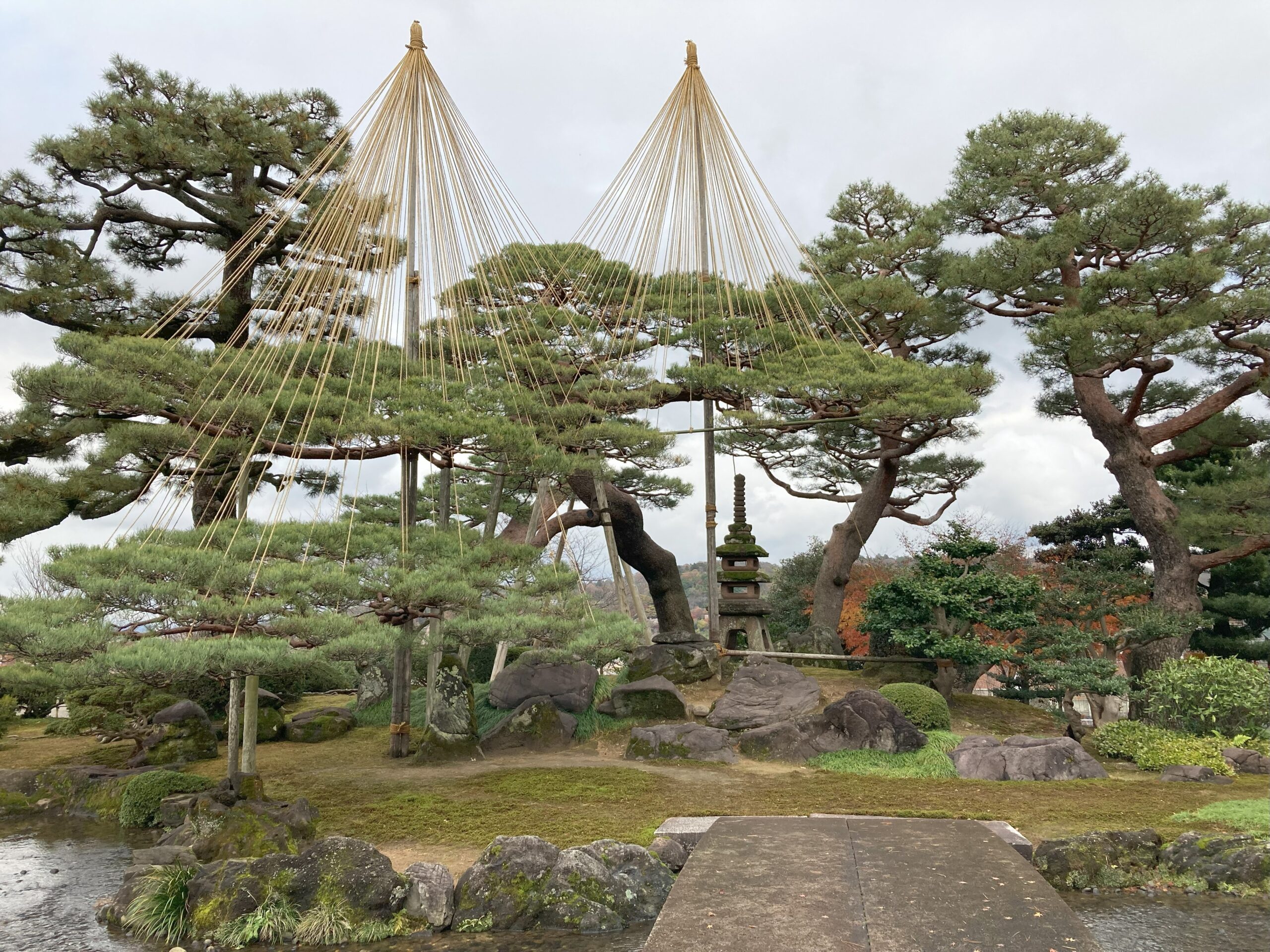
🔶今回も最後まで読んで頂き大変ありがとうございます。もし何かご意見やリクエストございましたらお気軽に『Help Desk』にてお声がけくださいませ。Gold🔶v.3a.2a.2a
